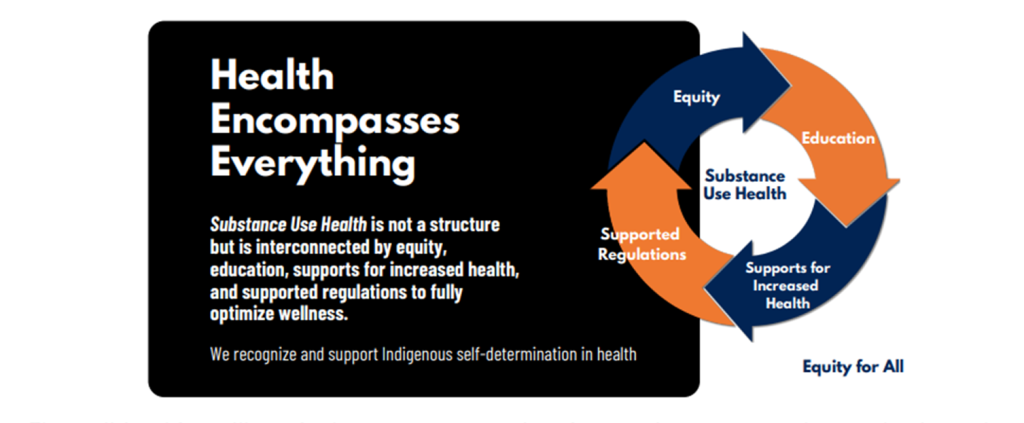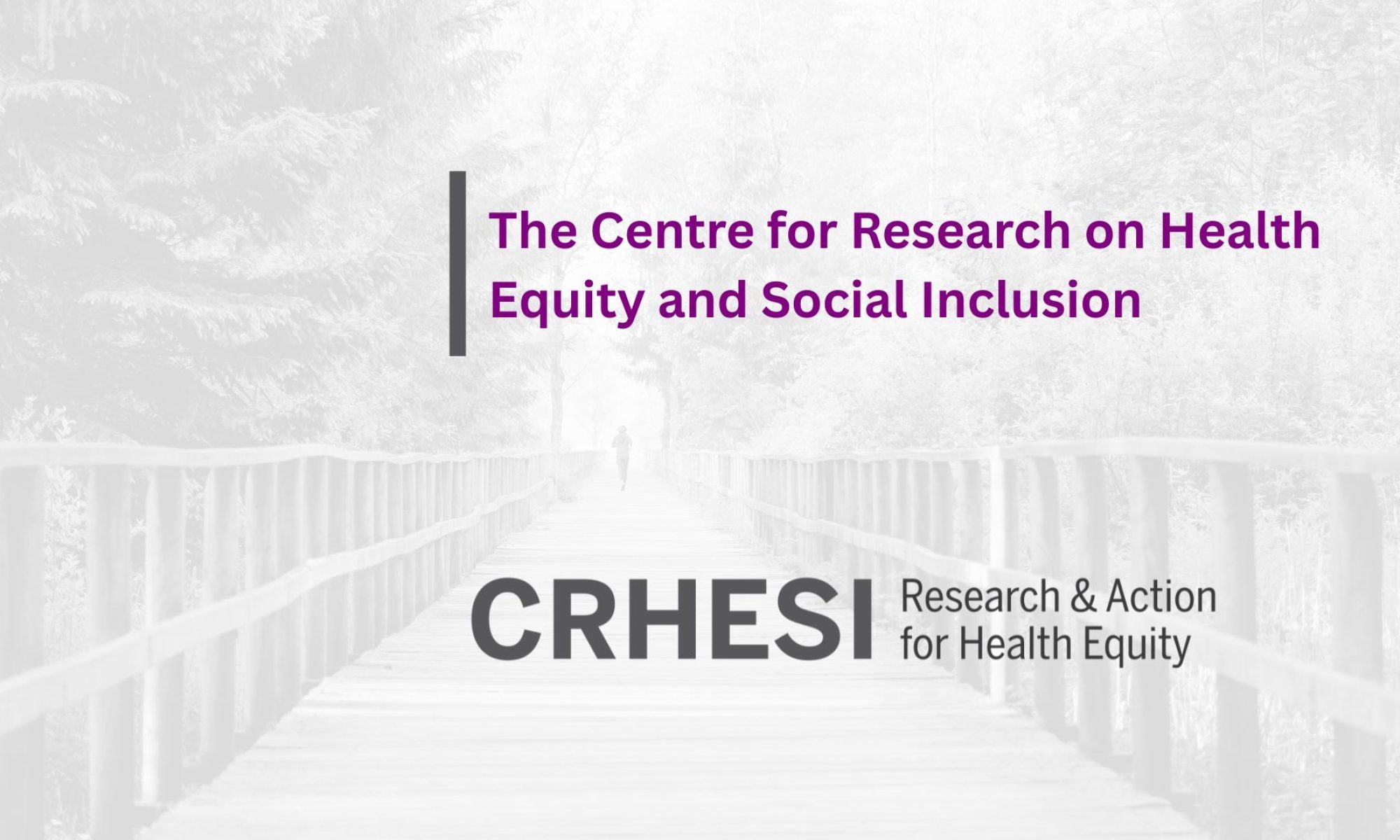Equity in Action: London InterCommunity Health Centre
This is part 3 of our 4-part series, which explores how London is implementing equity-oriented care. We provide some key background on tackling substance use stigma to promote substance use health, and then contextualize this through a conversation with a service provider from the London InterCommunity Health Centre (LIHC)’s emergency safer supply program for people using opioid drugs.
Substance Use Stigma and Discrimination
Substance use stigma is common and harmful, and especially targets people using certain (but not other) substances, and those from historically marginalized groups, including racialized people and those living in poverty.
As discussed in pervious posts in this series, EQUIP encourages us to learn from people’s lived and living experiences when shifting towards improving health and social services with an equity-oriented care approach.
The following video depicts the impact of substance use stigma in health care.
Key related links are:
The Safer Opioid Supply Program at London InterCommunity Health Centre
The Community Addiction Peer Support Association (CAPSA),
the Vancouver Community Action Team Anti-Stigma Working Group
Kílala Lelum Urban Indigenous Health and Healing Cooperative
EQUIP Health Care Research team
Understanding Substance Use Health
Recently, The Community Addiction Peer Support Association (CAPSA), released a substance use health resource to promote the importance of adopting an equity lens: UNDERSTANDING SUBSTANCE USE HEALTH: A MATTER OF EQUITY
The goals of the Substance Use Health (SUH) resource are to:
- update and standardize the definition of SUH
- inform a national conversation on how SUH can destigmatize substance use and to advance health system-level innovation within the care of clients and in the treatment of individuals
- confirm the All People All Pathways approach as a public health model
The All People All Pathways model of substace use health is barrier-free and client-partnered, functioning within a spectrum of substance use.

Promoting Substance Use Health in London, Ontario: The Safer Opioid Supply (SOS) Program
The London InterCommunity Health Centre (LIHC) launched the SOS program in 2016, which involves prescribing pharmaceutical opioids to people who are at a high risk of overdose due to the toxic street drug supply. Clients are prescribed pharmaceutical opioids as an alternative to fentanyl-adulterated street drugs. The SOS also program offers clients comprehensive health and social services such as primary care, management of infection such as HIV and hepatitis C, access to an interdisciplinary team for harm-reduction support, counselling, housing support and social services. This approach promotes engagement while caring for and managing co-existing conditions.
For those who use drugs, the SOS program aims for “expansion of treatment and harm reduction options”. This program strives for improved health outcomes, particularly reductions in emergency room visits, hospitalizations and drug use related infections. At the same time, these outcomes will reduce health costs. The way in which the SOS program works to achieve this is through prescribing and assisting in the safe injection of pharmaceutical opioids.
Evidence has shown that SOS programs can play an important role in expanding treatment and harm reduction for those who use drugs and who are at high-risk for drug-related illness.
For more information, please read:
Gomes, T., Kolla, G., McCormack, D., Sereda, A., Kitchen, S., & Antoniou, T. (2022). Clinical outcomes and health care costs among people entering a safer opioid supply program in Ontario. CMAJ, 194(36) https://www.cmaj.ca/content/194/36/E1233
Safer opioid supply program reduces ER visits, hospital admissions: Study
We took a deeper dive into the SOS program by speaking with Jessica Manzara, a Care Facilitator and Coordinator at LIHC, to understand how they engage with their participants.
I felt very fortunate to have spoken with Jessica and learn how the team at LIHC takes care of their clients.
Focusing on Equity-Oriented Care
About the caring team at the LIHC
Jessica Manzara, a care facilitator/coordinator at LIHC, is responsible for attending to the medical and social determinants of health for the people she works with. This includes finding support for income, transportation, community well-being, mental health, and reducing the harms of substance use. Jessica’s work involves complex care planning for those living with mental health issues and who use substances while also experiencing housing deprivation. As a care facilitator’ Jessica also coordinates a participant’s medical care, which could range from primary care and treatment for infections, to physiotherapy, home and community care, and advocacy when hospital services are needed.
Jessica refers to her clients as participants because the SOS program asks people to participate and this term conveys that they are, indeed, an active member and leader within their healthcare.
Jessica works collaboratively with one other care facilitator, as well as two prescribing physicians, a nursing team, and two outreach workers. With approximately 350 participants, this team is very busy!
“We have one of the largest safer opioid supply programs in the world” – Jessica Manzara, LIHC
Which groups does the SOS program serve?
Jessica told us that the SOS program serves “folks who are the most marginalized in the community”, for example those who live with complex co-occurring health and social problems, usually without permanent housing. The LIHC focuses on an adult population but will engage with high-risk youth as well as support people with high-risk pregnancies.
The SOS program team members are trained and specialize in trauma-informed and healing centered care and harm reduction. Jessica often works with people who are “opioid savvy” (e.g., using fentanyl, heroin, dilaudid, hydromorphone). To reduce and ideally eliminate substance use stigma and discrimination, the SOS program integrates a nonjudgmental approach. Jessica states that her team fights stigma by actively loving, caring, and empathizing with their participants.
Jessica says to participants, “You can’t tell us anything that’s going to make us think any differently of you because we care about you-who you are today versus who you might be a month from now versus a year from now and 10 years from now”.
What are some of the most important things about working to correct the harmful stigma related to substance use?
We heard that the most important strategy is building a community to create social inclusion and supportive conversations for people living with mental health issues and using substances. This fosters a partnership between the outreach team and participants, which is important in actively involving them in care planning. Engagement, caring, compassion and empathy are critical in understanding that participants often live with the effects of trauma and structural violence.
“This trauma could be structural from services that don’t match their needs, to services that aren’t available, to shelter space that is full, and it’s our job to create a caring environment where they feel safe and that their health is a priority.”
Jessica mentions that her outreach team does not ask their participants to change, rather they ask them to work in partnership.
“Success to us looks like you came in for your doctor day this week…and we want them to recognize that small success is still success, and that change happens in the most peculiar ways and that’s ok. And so, we don’t ask folks to stop using substances, rather we engage them around their substance use.”
“It’s about coming to this work knowing you’re going to learn and knowing that you’re entering into a partnership…we do this as a team and at the center of that team is our participant…”.
What might people be surprised to learn about those who use substances?
“The one thing we know about our folks is just because they use drugs doesn’t mean that they don’t want safety; just because they use drugs doesn’t mean they don’t deserve safety; just because they use drugs doesn’t mean they’re not engineers and nurses and that they had a life, a skill and a value before they became this quote-unquote addic.t”
Substance use is one aspect of a human’s life, and it is not a defining piece of who they are. Jessica emphasized that people who use substances are a part of a community that takes care of each other. “Folks who use drugs are these wonderful advocates who love each other and do love themselves. They just struggle with certain aspects of their lives because of the criminalization [of certain drugs] and because of the societal impact and stigma of what it means to be someone who uses substances”.
What are some barriers to caring for people who use substances?
Health systems and providers have an obligation to serve all populations. However, people who use substances are often blamed for their behaviour, and are often not seen as worthy of receiving healthcare “because they are self-inducing illness and infection”. It is important, as Jessica says, to “acknowledge the human at the center of all this and that this individual needs to be honored the most and not their diagnosis or the fact that they’re using substances”.
Which types of training are critical?
Jessica told us that harm reduction training is critical in limiting the harms of substance use and it is important to be substance savvy. This means knowing different types of substances and how they’re used, what they do, and how they’re talked about. It is also important to understand how to work with challenging behaviours, so crisis management and de-escalation skills are important.
“It’s really important for folks to be trauma informed and to really understand what healing-centered practices look like, whether it is supportive listening and being able to meet someone where they’re at, literally and figuratively. We have outreach workers that literally meet with folks on the street but then also philosophically meeting people where they’re at in their substance use, housing and medical care journeys”.
“Having outreach experience is really important as substance use always bumps up and always brushes against different social determinants of health. So, I would say being savvy and understanding the social determinants of health and how they impact a person and then knowing how each is interconnected”.
“Complex care planning is deeply rooted in equity and it’s because we want someone to have the same opportunity as any other person. What do we have to put in place to ensure that our participants have the same opportunities of care? It is important to always look through an equity lens in how we support our participants in having the best experience, like any other member of our community”.
A huge thank you to Jessica Manzara for taking the time to discuss the SOS program and how she engages with her participants.
For more information about the LIHC, please visit: https://lihc.on.ca/history/
Written by Samantha Campanella, Hooria Haider & Christine Garinger.
Interview led by Samantha Campanella, Honours Specialization in Health Sciences-Health Promotion, Western University
This series was developed by Samantha Campanella and Hooria Haider, Western University, Health Sciences Students, Community Engaged Learning placement with CRHESI

